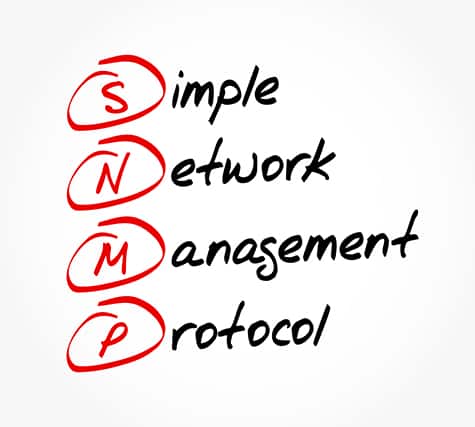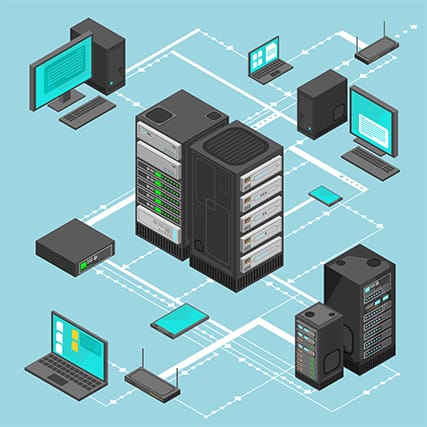
Table of Contents
1. SNMP (Simple Network Management Protocol)
SNMP is a widely used internet standard protocol for network monitoring. This protocol gathers and arranges data of managed devices on IP networks and stimulates device performance by modifying information. SNMP is now known as infrastructure monitoring because the entire company infrastructure and every company’s devices are covered. SNMP consists of two components, the manager and the agent. The manager is the host or software capable of handling the network information and the agent. An agent is a program, such as a router, which gathers information and delivers the data to the administrator.

The advantages of SNMP include starting an alert when a system node is unattainable or if the resources are inaccessible or overloaded to inform the administrator. SNMP comprises a compact protocol’s functional design that the operating system or the programming language cannot affect. SNMP enables flexibility because SNMP has an essential core set of activities that runs all over-monitored devices consistently. But SNMP has downsides, such as insufficient end-to-end visibility, improper analysis of performance issues of the network, inability to recognize software system errors that impact user traffic and network difficulty and virtualization that are barely prevented. SNMP is the best for single and multi-vendor LAN or WAN environments, as SNMP offers a usual network device mechanism to convey management information.
2. Flow-based Network Performance Monitoring Tools
Flow-based network performance monitoring tools process and catch traffic flow to gain complete protocol statistics on users in a link capacity. A network tap is a software agent, or network element, responsible for switching the user traffic to capture the traffic flows. Then, the captured traffic flows are delivered for storage and processing to the prominent collector. To copy traffic flows for further analysis by a flow collector, the flow-based network can set up the mirror port on a switch. SFlow, NetFlow and other kinds of protocols that start user traffic data can also be operated by the routers.
Advantages of flow-based network performance monitoring tools are data and interpretation of user traffic flows, breakdown of protocols within the network connections, recognition of top speakers and exploration of deep packet assessment. Disadvantages include high space consumption of disk, limited documented information, expensive taps, not collecting all traversing flows and more.
3. Active Network Monitoring
Active network monitoring is used to measure end-to-end reachability, duration, data loss, frequency, usage of links and other properties of a network by inserting actual data into the network. Active monitoring is done to check applications by performing actual deals and then estimating applications’ performance, execution and reaction time from the user’s viewpoint. The method helps users in checking network outcomes and applications, by implying the accessibility and performance of the applications without single monitoring.

Advantages of Active Network Monitoring include 24/7 monitoring, keeping large numbers of recorded data, verifying changes in configuration and not needing actual user traffic to develop KPIs. Disadvantages include consuming too many applications or network resources when conducting deals and requiring various software and hardware agents to install on the network. Active network monitoring is best for modifying a reachable site, as an active monitoring tool offers attainable monitoring.
What Is Network Monitoring?
Network monitoring offers information required by network executives to determine if the network is operating optimally or if there are any network security threats. Network administrators can effectively detect defects and other activities with the help of network monitoring tools. This is a network management subgroup responsible for identifying weak or faulty elements, including damaged, overloaded or frozen servers, failed routers, failed switches and others before any issue appears. These elements can damage a network. So Network monitoring assists industries understand what seems to be the usual performance for the network and helps identify issues easily.
What Are Network Monitoring Tools Used For?
The use of network monitoring tools is to inform network personnel if troubles emerge and trigger a system collapse. Network tools prevent defects and fix failing networks. Data analysis and collection are the two fundamental roles of a network monitoring program. These tools work by collecting data from active network devices, including routers, load balancers, switches, servers, reliable inquiries or firewalls that are analyzed to display the network’s status.
Who Makes Use of Network Monitoring Tools?
Network administrators and network users who own devices use network monitoring tools because network admins are responsible for working on network data and issues. Network administrators from large, small and mid-sized industries are multiplying and becoming standardized. The tools are changing because the users and the users’ needs are also changing. The number of users using networking monitoring tools is increasing.
Why Do People Require Network Monitoring Tools?
Networks are essential in worldwide business industries and play a significant role in serving employees for organizational purposes and clients. To keep the network unaffected, network monitoring tools gather data from the network gadgets that exist within the environment by utilizing network code. Traffic, high-frequency usage, packet loss, availability and others are some of several performance measurements that network monitoring tools can trace.
This is important:
Network monitoring tools are widely used to help users and administrators keep data centralized. Many people require network monitoring tools because monitoring data becomes available to people that need and control every supplemental incoming request. By monitoring the network availability, status and performance, users have an excellent experience, and the network maintains a rapid development.What Are the Best Network Monitoring Tools?
To monitor the network effectively, a user must carefully choose between the best network monitoring tools. Various network monitoring tools are available worldwide and provide the best-performing features to monitor the network successfully. But some network monitoring tools are best if used by experts or network administrators.
Listed below is the top selection of the best network monitoring tools.
- SolarWinds Network Performance Monitor (Best Overall): SolarWinds Network Performance Monitor is considered the best overall network monitoring tool because this tool offers simple solutions. SolarWinds can check the status of network devices with SNMP, making SolarWinds the leading network monitoring tool. SolarWinds enables users to automatically add discovery, collect a resource inventory and formulate a network topology chart spontaneously. SolarWinds operates well on Windows servers and offers 30 days of free usage.
- Auvik: A network monitoring tool that has multiple mechanical services. Mapping and setting up the backup and inventory are among Auvik’s services. Auvik has easy-to-use, fast and simple software in which network issues can be discovered, monitored and documented in a short time. Everything about the network can be visualized, and the tool automatically alerts the user or team once network issues are detected. Auvik also offers a 14-day free usage.
- Datadog Network Monitoring: Datadog supplies excellent network visibility and links between networks, such as cloud, integrated environment or on-premises. With the use of Datadog Network Monitoring, latency, transmission protocol control retransmits and more are easily tracked.
How Should I Select a Network Monitoring Tool?
Users must choose a practical and network monitoring tool to effectively implement and set up network monitoring. The best network monitoring tools should have services that support various devices. Any network problems, data breaches and failing applications that may slow the system devices can be prevented if users know how to select the best network monitoring tool. Automatic and programmable notification alerts, connection and device inventory should be connected and included in network monitoring tools.
Listed below are the ways to select network monitoring tools.
- Users must dig deeper and get an operative level network indicator.
- Make sure that the networks have excellent communication processes.
- Users must comprehend the topology of the network in active environments.
- Explore the interactive service of network monitoring tools.
- Assess network monitoring tools with active-level network ability that make monitoring easier.
- Choose network monitoring tools that provide health metrics for monitoring.
- Get only one network tool that offers complete monitoring.
How Can I Set up a Network Monitoring Tool?
Listed below are the steps to set up a network monitoring tool.

- Determine the Dangerous Devices on the Network: Identifying the dangerous devices and setting up a network monitoring system properly can help monitor the network effectively. Devices that can only support essential system functions or extremely used operating applications should be determined.
- Distinguish the Network Monitoring Guidelines: The network monitoring guidelines should be properly defined to keep users well informed. Constructing a policy includes guidelines, such as devices and tools to be monitored, data to be collected, access to the data, prompting alerts, notifications and the expected measures when an issue occurs.
- Setup WMI and SSH on Servers, Such as Windows and Linux: Servers are set up to function with the network’s WMI and SSH, allowing the network monitoring tool to pull thorough information regarding Windows and Linux systems. But advantaged credentials are necessary to get access to the data, including CPU, disk usage, memory and any system. Setting up a server is said to be as simple as supplying a password or an account name, but firewall or authentication problems may occur. The user needs to reset the antivirus or open a firewall port, troubleshoot Windows device authentication or SSH document verification if the issues occur.
- On Network Devices, Set up the SNMP: SNMP supplies useful information regarding the network devices’ status, same as WMI and SSH. Commonly used SNMP are network switches, hubs, printers and routers, but for security, the protocol of SNMP may be immobilized by default. When the SNMP immobilization happens, like a password, the user must facilitate the SNMP and the community line should be established.
- Set a Measure for the Performance of the Network: Setting a measure for network performance helps network administrators and users better understand if the device encounters unusual activity. By identifying and distinguishing the standard scope for gadget resource usage, the measurement for network performance can figure out what is considered “normal” on the network. Some servers use more memory space because users want excellent performance, running almost 90% of the server. Setting up a baseline by conducting a comparison to the other device is useful to determine if the device encounters abnormal performance.
- Customize Levels of Thresholds and Put Up Alerts: Putting up alerts to notify the user if the disk’s space is decreasing enables users to recognize if the switch is experiencing a strange data loss. Information and alerts are needed for network monitoring software to analyze the flow of the device’s activity. For example, users want alerts to notify of any possible inappropriate performance, but not that alerts become too much because of overwhelming nonsense notifications. There is a high possibility that alerts about actual emergencies will be ignored because users receive excessive notifications. To prevent receiving “false information” or “false alarms” and to get relevant alerts, users must customize and align the thresholds with established baselines. Disabling particular kinds of revert alerts that are unimportant to the user is another best way to lessen alert fatigue.
- Make a Plan for Receiving Alert Notification: Getting the actual alerts helps fix or clear out issues on the network. Making a plan for receiving alerts includes prioritization and handling of notifications, especially for users with lots of work or who have a large team of staff expecting to receive many notifications a day. Users must know which network personnel should be contacted in what case, and what should be the next thing to do when an alert is received. An alert notification about network monitoring requires immediate attention from staff members to prevent the issue from completely affecting the network.
- Observe the Devices: Observing the devices is one of the primary goals of network monitoring to lessen failing systems by observing the device’s and network’s workflow. Monitoring of the devices also prevents emails, websites or applications that the user depends on from being infected. Once the user sets up the networking tools to operate the alerts, the user can now monitor all other present conditions of the network. Including resources in the dashboard that can assist users in recognizing issues before the issues turn into bigger problems. Keeping everything up to date is advisable for users after setting up a network monitoring tool. To keep receiving relevant notification alerts, the alert threshold should be updated if something in the environment changes or if the user adds a new device.

